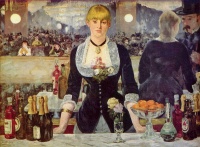Music
From The Art and Popular Culture Encyclopedia

|
"All art constantly aspires towards the condition of music" -- Walter Pater "As far as biological cause and effect are concerned, music is useless. It shows no signs of design for attaining a goal such as long life, grandchildren, or the accurate perception and prediction of the world." --How the Mind Works (1997) by Steven Pinker |
.jpg)
Illustration: Sheet music to "Buffalo Gals" (c. 1840), a traditional song.
Maxim: "writing about music is like dancing about architecture".

Illustration: A Bar at the Folies-Bergère by French painter Édouard Manet.

_by_Annie_Besant_&_Charles_Webster_Leadbeater.jpg)
|
Related e |
|
Featured: |
Music is an art form whose medium is sound and silence. Its common elements are pitch (which governs melody and harmony), rhythm (and its associated concepts tempo, meter, and articulation), dynamics, and the sonic qualities of timbre and texture. The word derives from Greek μουσική (mousike; "art of the Muses").
The creation, performance, significance, and even the definition of music vary according to culture and social context. Music ranges from strictly organized compositions (and their recreation in performance), through improvisational music to aleatoric forms. Music can be divided into genres and subgenres, although the dividing lines and relationships between music genres are often subtle, sometimes open to individual interpretation, and occasionally controversial. Within the arts, music may be classified as a performing art, a fine art, and auditory art. It may also be divided among art music and folk music. There is also a strong connection between music and mathematics. Music may be played and heard live, may be part of a dramatic work or film, or may be recorded.
To many people in many cultures, music is an important part of their way of life. Ancient Greek and Indian philosophers defined music as tones ordered horizontally as melodies and vertically as harmonies. Common sayings such as "the harmony of the spheres" and "it is music to my ears" point to the notion that music is often ordered and pleasant to listen to. However, 20th-century composer John Cage thought that any sound can be music, saying, for example, "There is no noise, only sound."
Much of the focus of this site lies on genres such as disco (99 Records, August Darnell, Larry Levan, Patrick Adams and Arthur Russell), house, funk (P-Funk) and techno (Detroit techno) on the one hand and dub and reggae (King Tubby, Bob Marley, Lee Perry, Studio One) on the other.
Contents |
History
Music is found in every known culture, past and present, varying wildly between times and places. Scientists now believe that modern humans emerged from Africa 160,000 years ago. Around 50,000 years ago these humans began to disperse from Africa reaching all the habitable continents. Since all peoples of the world including the most isolated tribal groups, have a form of music, scientists conclude that music must have been present in the ancestral population prior to the dispersal of humans around the world. Consequently music must have been in existence for at least 50,000 years and the first music must have been invented in Africa and then evolved to become a fundamental constituent of human life.
A culture's music is influenced by all other aspects of that culture, including social and economic organization, climate, and access to technology. The emotions and ideas that music expresses, the situations in which music is played and listened to, and the attitudes toward music players and composers all vary between regions and periods. "Music history" is the distinct subfield of musicology and history which studies music (particularly western art music) from a chronological perspective.
19th century music
In the later decades of the 19th century, the music industry became dominated by a group of publishers and song-writers in New York City that came to be known as Tin Pan Alley. Tin Pan Alley's representatives spread throughout the country, buying local hits for their publishers and pushing their publisher's latest songs. Song demonstrators were fixtures at department stores and music stores across the country, and traveling song demonstrators made circuits of rural areas. The industry was driven by the profits from the sales of sheet music. A piano was considered a must in any middle-class or higher home. Major 19th century Tin Pan Alley hits included "Only a Bird in a Guilded Cage" and "After the Ball Is Over".
20th century music
The 20th Century saw a revolution in music listening as the radio gained popularity worldwide and new media and technologies were developed to record, capture, reproduce and distribute music. Because music was no longer limited to concerts and clubs, it became possible for music artists to quickly gain fame nationwide and sometimes worldwide. Conversely, audiences were able to be exposed to a wider range of music than ever before. Music performances became increasingly visual with the broadcast and recording of music videos and concerts. Music of all kinds also became increasingly portable. Headphones allowed people sitting next to each other to listen to entirely different performances or share the same performance.
20th Century music brought a new freedom and wide experimentation with new musical styles and forms that challenged the accepted rules of music of earlier periods. The invention of musical amplification and electronic instruments, especially the synthesizer, in the mid-20th century revolutionized popular music and accelerated the development of new forms of music.
Research interests
- Cultural appropriation in western music
- History of dance music
- History of disco
- Earworm
- Experimental music
- European music
- Proto- (music qualifier)
- Railway music
- Rockism
- Étude aux chemins de fer
- Burundi beat
- Towards a Balearic playlist
- The most famous giggles in late 20th century dance music
- Heavy breathing in music
- World music classics
Compilations
References
- Cut 'n' Mix: Culture, Identity and Caribbean Music by Dick Hebdige
- Ocean of Sound by David Toop
- Last Night a DJ Saved My Life by Bill Brewster and Frank Broughton
See also

